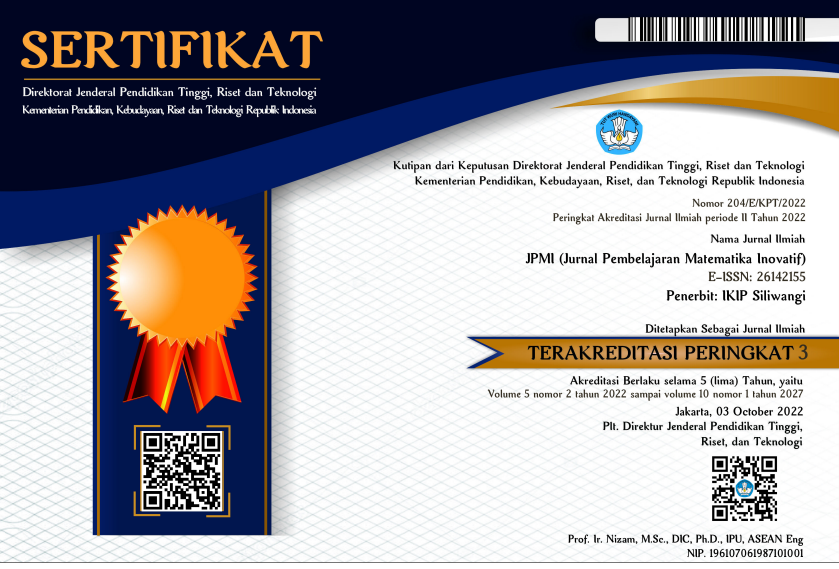ANALISIS STRATEGI PQ4R DENGAN PENDEKATAN SAINTIFIK TERHADAP HASIL BELAJAR SISWA PADA TOPIK ALJABAR
DOI:
https://doi.org/10.22460/jpmi.v3i4.p%25pKeywords:
PQ4R, Scientific, AlgebraAbstract
References
Annizar, A. M., Maulyda, M. A., Khairunnisa, G. F., & Hijriani, L. (2020). Kemampuan Pemecahan Masalah Matematis Siswa dalam Menyelesaikan Soal PISA pada Topik Geometri. Jurnal Elemen, 6(1), 39–55. https://doi.org/10.29408/jel.v6i1.1688
Creswell, J. W. (2012). Educational research: Planning, conducting, and evaluating quantitative and qualitative research. In Educational Research (Vol. 4). https://doi.org/10.1017/CBO9781107415324.004
Donuata, P. B. (2019). Pengaruh quantum teaching metode PQ4R berdasarkan keragaman kecerdasan terhadap hasil belajar fisika. JRKPF, 6(1), 23–27. https://doi.org/http://dx.doi.org/10.12928/jrkpf.v6i1.11094
Gilakjani, A. P. (2012). A Match or Mismatch Between Learning Styles of The Teachers. International Journal Modern Education and Computer Science, 1(1), 51–60.
Hasanah, A., Kusumah, Y. S., & ’Ulya, Z. (2017). Visual Communication-Based Mathematics Learning Material for Deaf Students. Journal of Mathematics and Science Teaching, 22(2), 66–77.
Hraste, M., Giorgio, A. De, Mandi, P., Padulo, J., & Grani, I. (2018). When mathematics meets physical activity in the school-aged child : The effect of an integrated motor and cognitive approach to learning geometry. PLoS ONE, 13(8), 1–14. https://doi.org/https://doi.org/10.1371/journal. pone.0196024
Istiqomah, F., Rochmad, & Mulyono. (2017). Mathematical Creative Thinking Ability of the Seventh Grade Students in Terms of Learning Styles to the Preview-Question-Read-Reflect-Recite-Review (PQ4R) Learning. Unnes Journal OfMathematics Education, 6(2), 258–267. https://doi.org/10.15294/ujme.v6i2.17201
Jay, T., Rose, J., & Simmons, B. (2018). Why Is Parental Involvement in Children ’ s Mathematics Learning Hard ? Parental Perspectives on Their Role Supporting Children ’ s Learning. SAGE Open, 4(14), 1–13. https://doi.org/10.1177/2158244018775466
Khoirunisa, A., Haryati, S., & Rery, R. U. (2019). Pengembangan Lembar Kegiatan Peserta Didik (LKPD) Berbasis Preview, Question, Read, Reflect, Recite, Review (PQ4R) Pada Pokok Bahasan Kesetimbangan Ion dan pH Larutan Garam. Jurnal Pembelajaran Kimia, 4(2), 74–80.
Leatham, K. R., Peterson, B. E., Stockero, S. L., & Zoest, L. R. Van. (2015). Conceptualizing Mathematically Significant Pedagogical Opportunities to Build on Student Thinking. Journal for Research in Mathematics Education, 46(1), 88–124. https://doi.org/10.5951/jresematheduc.46.1.0088
Maharani, H. R. (2014). Creative Thinking in Mathematics: Are We Able to Solve Mahematical Problems in a Variety of Way? International Conference on Mathematics, Science, and Education, 23. Semarang: Universitas Negeri Semarang.
Maulyda, A. M., Hidayati, V. R., Erfan, M., Umar, & Sutisna, D. (2020). Kesalahan Komunikasi Matematis (Tertulis) Siswa Ketika Memahami Soal Cerita. Jurnal Karya Pendidikan Matematika, 7(1), 1–7.
Maulyda, M. A., Annizar, A. M., Hidayati, V. R., & Mukhlis, M. (2020). Analysis of students ’ verbal and written mathematical communication error in solving word problem. Journal of Physics: Conference Series, 1538(012083), 1–12. https://doi.org/10.1088/1742-6596/1538/1/012083
Maulyda, M. A., Rahmatih, A. N., Gunawan, Hidayati, V. R., & Erfan, M. (2020). Retroactive Thinking Interference of Grade VI Students : A Study on the Topics of PISA Literacy Lessons. Journal of Physics: Conference Series, 1471(Maret), 1–7. https://doi.org/10.1088/1742-6596/1471/1/012037
Obasi, C., & Ugo, C. (2018). Predicting Growth Rate of Students ’ Achievement in Mathematics Using Mathematical Growth Model. SJME : Supremum Journal of Mathematics Education, 2(2), 44–51.
Pike, G. R., Hansen, M. J., & Childress, J. E. (2014). The influence of students’ pre-college characteristics, high school experiences, college expectations, and initial enrollment characteristics on degree attainment. Journal of College Student Retention, 16(1), 1–23.
Rodli, M. (2015). Applying PQ4R Strategy for Teaching Reading. Indonesian EFL Journal: Journal of ELT, Linguistics, and Literature, 1(1), 34–46.
Rutschow, E. Z., & Mayer, A. K. (2018). Early findings from a national survey of developmental education practices. Journal of Education and Training, 2(4), 78–89.
Saxon, P., & Martirosyan, N. M. (2017). NADE members respond: Improving accelerated developmental mathematics courses. Journal of Developmental Education, 41(1), 24–27.
Staats, S., & Laster, L. A. (2018). Extending Universal Design for Learning through Concurrent Enrollment : Algebra Teachers ’ Perspectives. Education Sciences, 8(154), 1–19. https://doi.org/10.3390/educsci8040154
Triana, M., & Zubainur, C. M. (2019). Students ’ Mathematical Communication Ability through the Brain-Based Learning Approach using Autograph. Journal of Research and Advances in Mathematics Education, 4(1), 1–10.
Yuliana, I., & Fajriah, N. (2013). Penerapan Metode PQ4R dalam Pembelajran Matematika di Kelas VII SMP. Jurnal Pendidikan Matematika, 1(1), 27–33.

















